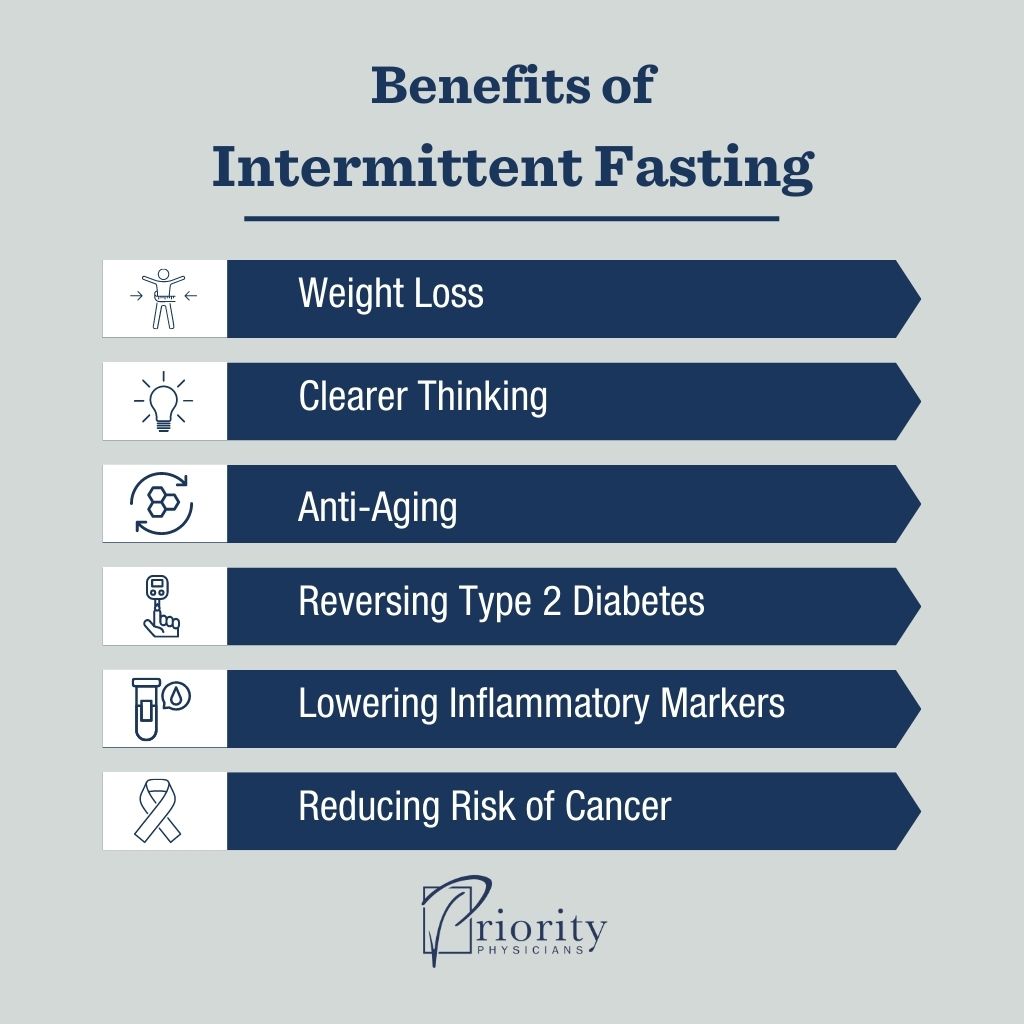Whenever a new diet becomes popular, health professionals get a lot of questions. Sometimes we have to spend a lot of time and energy debunking a popular fad or convincing our patients why the latest trend isn’t a cure-all.
So when intermittent fasting first came into the spotlight, some of us were reluctant to get on board. It seemed like just another fad diet.
But as more and more data became available, we realized intermittent fasting isn’t some new gimmick. Research shows this method of eating can, in fact, convey huge benefits.
Consider this post a beginner’s guide to intermittent fasting.
All Feast, No Famine
We’re living in a time of plenty. We have more access to food today than ever before. But our bodies aren’t made for this constant excess.
For most of human history, we didn’t know where our next meal was coming from. Our bodies fluctuated between feast and famine, latching onto as many calories as possible when available, and storing them for as long as possible against future hunger.
But for most of us today, the famine never comes. Instead, we have excess calories around us and in us all of the time. And our bodies hold on to them — just like they always have.
What Is Intermittent Fasting?
Intermittent fasting is when you restrict your caloric intake to a certain time window each day. It’s time-restricted eating.
So, for example, you might only eat from 11 a.m. to 7 p.m., and outside of that eating window, you only drink water. This not only gives your body time to process the food you took in, it also tricks your body into using a different form of metabolism.
When you eat all day long, your body uses all that readily available sugar as fuel. But when you fast, you force your body to start breaking down stored fat for energy. A process called ketogenesis turns this stored fat turns into ketones, which become the body’s new fuel source.
What Are the Risks of Intermittent Fasting?
For a healthy individual, intermittent fasting poses virtually no risk. Because you’re not even paying to join a diet group or meal service, there’s also not a financial risk. In fact, it could even help you save money.
However, intermittent fasting is not for people who have type 1 diabetes or a history of eating disorders. It also isn’t for children under 18 or for women who are pregnant or breastfeeding.
What Are the Benefits of Intermittent Fasting?
Weight Loss
One benefit of intermittent fasting is weight loss. Studies indicate that intermittent fasting is as effective as calorie restriction for losing weight. So if you struggle with counting calories or have difficulty cutting out certain foods to lose weight, intermittent fasting could help.
Clearer Thinking
Ketones, which your body makes during the fasting state, are actually the preferred fuel source for the brain. A diet high in sugar can cause issues such as brain fog, irritability, anxiety, and depression, but many people report they can think more clearly when they fast.
Anti-Aging
Anti-aging may fall more on the hype side in this case, but it’s worth mentioning. While evidence is mixed, some studies seem to show at least the possibility of anti-aging benefits from intermittent fasting. As more research is completed, we’ll better understand whether a link exists between the two.
Reversing Type 2 Diabetes
Another major benefit of intermittent fasting is the reversal of metabolic disorders, including type 2 diabetes. It does this by reducing body fat and lowering the insulin resistance of your cells, effectively reprogramming your metabolism to function normally.

Lowering Inflammatory Markers
When your body isn’t constantly digesting food, it can do some maintenance. Fasting may reduce inflammation and oxidative stress in the body, allowing cells to repair and regenerate.
Decreasing Risk of Cancer
As if all the other benefits weren’t enough, intermittent fasting may also decrease your risk of developing cancer.
Most of us know that by avoiding certain well-known risk factors, like smoking and UV exposure, we avoid increasing our risk of cancer in the future. However, there aren’t many actions we can take to actively lower our risk for all types of cancer. Fasting is one of them.
When you fast, you release stem cells that go out into the body to repair or replace damaged cells. Those damaged cells are what we think lead to cancer in the long term.
This free, relatively simple behavior shift is an incredible tool you can use — starting now — to forever reduce your risk of cancer.
Pros and Cons of Common Fasting Schedules
No one really knows what the “best” fasting schedule is, but people tend to follow one of three schedules for intermittent fasting.

16:8
The 16:8 schedule means that you fast for 16 hours and eat for 8. It’s probably the most popular fasting schedule because it’s the easiest to follow.
A 16:8 schedule usually looks like skipping breakfast, having your first meal at noon, and making sure you don’t put food in your mouth past 8 p.m. After skipping breakfast for several days, most people don’t even get hungry in the mornings anymore.
18:6
The 18:6 schedule is a little more intense, with fasting for 18 hours and eating for 6. You might think of this as the overachiever schedule. It’s not an attainable or sustainable goal for everyone.
We don’t generally recommend most people fast for longer than 18 hours.
14:10
If you’re brand new to intermittent fasting, the 14:10 schedule is a good place to start. Fourteen hours of fasting and 10 hours for eating isn’t too big of a stretch for most people. However, if that still seems like too much, start with a 12:12. What’s most important is to find a schedule that works for you, and then commit to it.
We don’t know enough about intermittent fasting and its effects to definitively say what an ideal fasting schedule is or even how often it should be done. What we do know is that committing to fasting improves health outcomes and even daily life.
Build a Simple Routine
Building an intermittent fasting routine doesn’t have to be complicated or overwhelming. In fact, your life should be the guide for your intermittent fasting schedule. If you enjoy breakfast with your kids on the weekends, for example, opt for five fasting days a week instead of seven. Use simple reminders about fasting windows, like alerts on your phone or notes on your fridge.
This may be controversial, but when you commit to intermittent fasting, you don’t even have to make drastic changes to what you eat.
When you fast, your body handles food differently. It switches into that alternative form of metabolism. So even if you eat the same 2,000 calories you always eat, you’ll still see benefits from eating those calories during a shorter time period.
That being said, certain foods might affect you in different ways. For example, eating nuts to break your fast might be a better option than cereal. A dietitian can help you create optimal meal plans for your intermittent fasting schedule.
The Bottom Line on Intermittent Fasting
Most people have nothing to lose and everything to gain with intermittent fasting. It costs nothing, there’s no risk, and you don’t even have to cut out all your favorite foods. You just change when you eat.
If you think intermittent fasting could be a good fit, talk with your physician about whether this simple lifestyle change is right for you.

